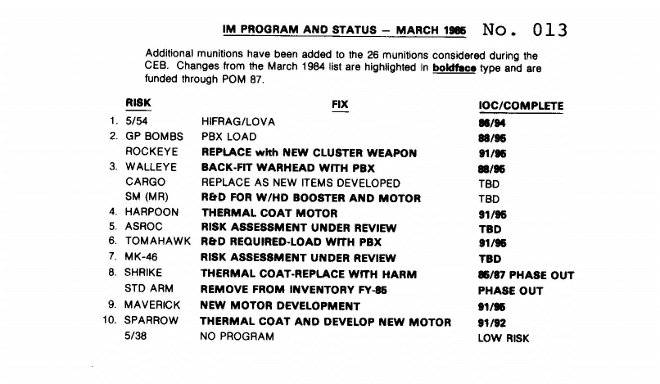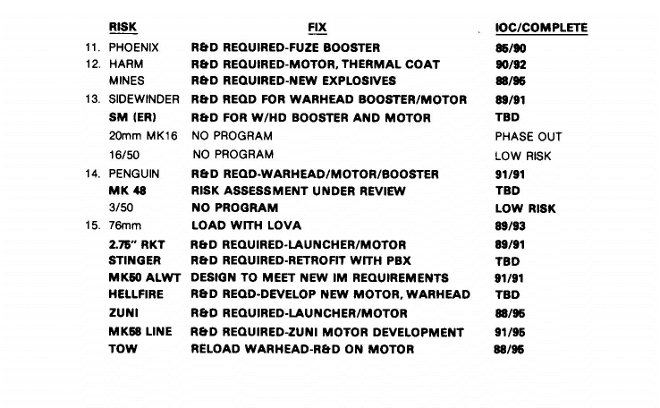We distributed the final draft of the NAVSEA Instruction defining the technical requirements for insensitive munitions for comment to the Navy Weapons Centers, the Naval Air Systems Command, and the Naval Material Command in July 1984. This draft was produced after extensive consultations with explosives scientists and munitions technologists from the Naval Surface Warfare Center, Dahlgren and White Oak Laboratories, and the Naval Air Warfare Center, China Lake. The requirements and criteria selected to define an insensitive munition were based on the stimuli most likely to be encountered in a combat environment and on the sensitivity characteristics of the new explosives that we expected would be used in Navy munitions.
For reasons unknown to me, this draft was ”bottled up” in the programmatics office for several months. It was finally released after I, by happenstance, met RAdm. Meyer in the men’s room. He asked me about the status of the NAVSEA Instruction on Insensitive Munitions. I told him that I had sent it to CAPT. Cadow in July of 84 and had not seen it since. After I returned to my office, I received a phone call from Capt. Cadow, the draft Instruction was found in the “Programmatics” office and sent to the Admiral for approval.
On 22 May 1985, NAVSEA issued NAVSEAINST 8010.5 “Technical Requirements for Insensitive Munitions”.55 The document required the following:
- Insensitive munitions determinations based on tests of munition items in the service configurations.
- Threat assessments based on a hazard analysis that included combat-induced environments. These were to be performed by the cognizant program offices and included in the documentation package for the initial WSESRB review.
- The criteria listed were goals to strive for achievement by 1995.
- Insensitive Munitions Coordinating Group approval was required for the introduction into service of new items not meeting the IM criteria.
The following test requirements and passing criteria were documented in NAVSEAINST 8010.5
| TESTS | CRITERIA |
|---|---|
| Slow Cook-off | No reaction more severe than burning. Record internal temperature at the energetic material/inert interface at reaction and blast overpressures. |
| Fast Cook-off | No reaction more severe than burning. Record fire temperature, blast overpressures, and location of debris. |
| Bullet Impact | No reaction more violent than burning. Record blast overpressures, and location of debris. Camera coverage required. |
| Fragment Impact* | Assessment and credible event analysis. No reaction more violent than burning. |
| Sympathetic Detonation* (In planned stowage magazine or launcher configuration; by tests or supportable analysis) | Assessment and credible event analysis. No sympathetic detonation in stowage configuration. |
| Sensitivity to Electromagnetic Radiation* | Assessment of EMP vulnerability. No explosive event. |
* “Tests may be required. Assessment per Navy Safety Improvement Pierside Safety Program. Data on energetic materials in test items … are required”. |
The slow cook-off, fast cook-off, and bullet impact tests for munitions were well defined at that time as they had been performed as part of the WR-5056 tests. There were no documented tests or procedures for fragment impact, sympathetic detonation, and sensitivity to electromagnetic radiation. These were new requirements. We believed that a credible event analysis, data obtained with generic, munition size, warheads and an assessment based on the sensitivity of the energetic materials would suffice to satisfy the IM requirements.
There was some concern about the cost and statistical significance of performing one or two tests on expensive munitions. Also, we questioned our ability to perform reasonable sensitivity assessments using only the limited data available from the munition tests. DOD-STD-210557 required tests on only two munitions per stimuli, i.e. two for slow cook-off, two for fast cook-off, etc. To minimize the costs and provide additional information for use in the IM assessments, NAVSEAINST 8010.5 stated the following.
“In addition to the requirements of reference (e),58 new energetic materials will undergo testing in munition- size hardware such as described in references (f)59 and (g).60 These tests will provide the reliable data necessary to assess the relative sensitivity of the materials in realistic situations and at more reasonable costs than all-up munitions testing. Appropriate propellant and pyrotechnic materials test hardware will be developed as part of the insensitive munitions technology base program. The following data are required:
- Slow Cook-Off
- Fast Cook-Off
- Sympathetic Detonation
- Multiple Bullet Impact
- Multiple Fragment Impact
- Critical Diameter (measured or calculated)
Some explosives experts questioned whether a burning only reaction could be achieved in slow cook-off tests with compositions containing ammonium perchlorate (AP). It was well known that AP explodes violently when heated slowly. Adding fuel could only aggravate the problem. For AP containing explosives, We recommended that “no detonation” be the criterion assigned for slow cook-off. After some discussion with CAPT. Cadow and me, RAdm. Meyer decided to “challenge the technical community” and leave burning as the criterion. He reasoned that after about one year, if it still seemed unreasonable, the instruction could be changed.
To assure uniformity in reporting the IM data, NAVSEAINST 8010.5 defined the following types of reactions that could be reported and used to assess IM policy compliance:
“Detonation (Type I)*61. A supersonic reaction which propagates through the explosive and produces an intense shock in the surrounding medium. When the explosive is encased, there will be very rapid plastic deformation of the encasing material, followed by extensive fragmentation. A detonating munition produces the maximum blast and fragmentation damage it is capable of producing.
Partial Detonation (Type II)*. Only part of the explosive in the munition detonates. A shock wave is formed and some of the case is fragmented as in detonation. The amount of damage, relative to a full detonation, depends on the portion of material that detonates.
Explosion (Type III)*. A sudden release of gases caused by the violent rupture of the container. Metal cases are broken into pieces by brittle fracture of the case. Large or small pieces of the case are often thrown long distances. Unreacted and burning energetic material is also thrown about. Air shocks are produced that can cause damage to nearby structures. The blast and high velocity debris can cause minor ground craters for items on or near the ground or damage such as dents, or break up of plates for items on or near metal plates. There will be no plastic flow of the metal as occurs in a detonation reaction. Blast pressures, reasonably close to the munition, are considerably lower than for a detonation of the item in question; however the high-energy debris could cause the detonation of ordnance stored nearby.
Deflagration (Type IV)*. The munition case ruptures and may expel burning material that can cause fires. The munition or parts of it can be propelled some distance if not constrained. Some overpressure will occur due to the sudden venting of the case, and fire and smoke hazards will exist. Propelled pieces may not be “hazardous fragments” [author’s note: 58 ft-lbs or greater] as defined above, but the reaction would not be expected to cause detonation of munitions stored nearby.
Burning (Type V)* . The energetic material ignites and burns. The case may melt or weaken sufficiently to allow mild release of the combustion gases. Debris stays in the area of the fire. Case closures may be dislodged by internal pressure and thrown up to about 50 feet. These however will not be “hazardous fragments” as defined above, beyond that distance.”
In December 1984, RAdm. Nyquist, OP-35, formed what he called “The Insensitive Munitions Zealots” to focus attention on the Navy IM program. Pocket cards were printed and distributed in the Pentagon and the System Commands. The CNO, Adm. Watkins, was given card number one.
The Zealot cards provided, at a glance, the munition priorities, the possible “fix”, and the completion dates for each weapon considered to have sensitivity problems. The “IM Zealot” cards were to be updated every six months. The January 1994 version of the card is provided below. The front and back of a Zealot pocket card are shown.
55NAVSEAINST 8010.5 Ser. 06IR/211 of 22 May 85; Subject: Technical Requirements for Insensitive Munitions.
56WR-50, Op. cit.
57DOD-STD-2105 (NAVY), Hazard Assessment Tests for Navy Non-Non-Nuclear Ordnance, Dated 9 September 1982.
58NAVSEAINST 8020.5A; Subject: Qualification and Final (Type) Qualification Procedures for Navy Explosive Materials, dated 10 September 1984.
59NWC TP6118; Subject: NWC Standard Methods for the Determination of the Thermal Properties of Propellants and Explosives, March 1980.
60NSWC TR 83-53; Subject: Large Scale Safety, Vulnerability, and Performance Test Procedures, May 1983.
61* Denotes reactions that were later identified by “Types” (i.e. Type I = detonation) in the U.S. MIL-Standards. These Type designations were later adopted to identify reaction levels by other countries and NATO.

